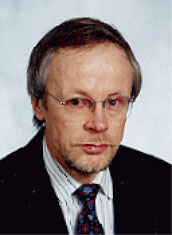

Pekka Pyykkö

Born October 12, 1941 in Hinnerjoki, Finland.
Professor of Chemistry at University of Helsinki, Finland 1984-. Emeritus status Nov. 2009.
Email:Pekka.Pyykko@helsinki.fi
WWW: external link
Member of Finska Vetenskaps-Societeten, Suomalainen Tiedeakatemia, Kungliga Vetenskapssamhället i Uppsala, European Academy of Arts, Sciences and Letters, Bayerische Akademie der Wissenschaften, Academia Europea, and Kungliga Vetenskapsakademien. Decorated by the President of Finland (FVR R I, 1995). A. I. Virtanen Prize 1997. E. J. Nyström Prize 1998, Humboldt Prize 2002, Palmes Académiques 2009, Schrödinger medal 2012, Honorary Fellow of Chinese Chemical Society 2012.
Author of:
Over 330 scientific papers and the bibliography "Relativistic Theory of Atoms and Molecules I–III" (Springer, Berlin, 1986, 1993, 2000). See home page.
Important Contributions:
- Pyykkö started his scientific activity as a solid-state NMR spectroscopist.
- The chemical and physical differences between 5th-Period and 6th-Period elements seem to be largely due to relativity. Relativistic effects also sometimes strongly affect bond lengths (Desclaux and Pyykkö 1974), bond strengths and optical properties, not to mention NMR parameters, where they can be very large. Since 1971, he has been publishing in this area. The main results have now entered many elementary and advanced textbooks in inorganic chemistry. These effects of the Dirac dynamics are changed by about –1% for the valence electrons of heavy elements by the next physical level, QED, as shown in 1998.
- Three further main activities since the 1990s have been the study of strong closed-shell interactions ('metallophilic' attractions) in inorganic chemistry, the determination of nuclear quadrupole moments by combining accurate EFG calculations and spectroscopic data (CRC Handbook 1993–), and the prediction of new inorganic species. Several have been made and characterised: PBP3-, NBC4-, FCNF+, N5+ in salts and PS3-, NUO+, AuXe+, XeAuXe+, WAu12 and OUIr+ in mass spectroscopy, CdH2 in matrices, and OCNCO+ in both the gas-phase and in bulk compounds.
- Recent, broad interests: The chemistry of gold, actinides and 5g superheavies. The mechanisms behind the Periodic Table. Improved covalent radii.